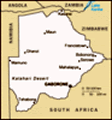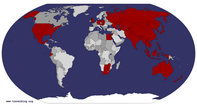Advertisement
Published: February 18th 2016
.
Going down to breakfast we watched the
red wing starlings and
spur winged geese. In the dining room there was humour in watching the staff continually chasing out the
velvet monkeys. We ate a hearty breakfast and then we loaded up into the vans ready for our day trip to Botswana.
.
The road was long but not winding and the
warthogs were out in force. We almost had a collision with a
yellow billed hornbill. At last we saw the lime-vested border police.
.
We had learned that Botswana gained independence in 1966 but the old colonial bureaucracy was still extant. We lined up to walk through the hut which passed as the immigration office. The staff were incredibly friendly. Once we had cleared immigration we noticed that on the road leading from Botswana out to the border there seemed to be hundreds of juggernauts laden with stuff being exported from Botswana to the rest of Africa. It can take two months to pass through customs. There is a single pontoon from Botswana across the river and therefore only a limited number of vehicles can pass in any one day.
.
On
the Botswana side of the border there is an air of less poverty. Our driver was asked about the country and he said that in Botswana there was high employment, less crime and less corruption than Zimbabwe. In fact when asked if he would want to work in Cape Town he answered “No, there is too much crime there.” He reckoned that he could leave his 4 x 4 unlocked and unattended for several days in Botswana and that it would still be safe.
.
Onward to the Chobe Safari Lodge to board the boat for a cruise on the Chobe River. Botswana borders Namibia, Zimbabwe and Zambia. There was a territorial dispute with Namibia over a small island (only 5 square kilometers) in the middle of the river called Sududu Island as to its ownership. The matter went to the Hague where officials of the International Court of Justice came and measured the depth of the channels between the island and the two countries. They came to the conclusion that because in a very dry season the island would be more likely to connect to the mainland of Botswana, therefore the island belonged to Botswana. As we
went along the river we passed a military training camp and we were told not to take pictures.
.
The area is very green and fertile and full of wild animals but the landscape is scarred with dead trees. This is because of the tsetse fly. The tsetse fly’s bite can be treacherous. It can cause sleeping sickness (something I remember from my geography lessons way back when!) In order to exterminate the tsetse fly the area was sprayed with DDT which not only killed the fly but also killed the trees and some animals.
.
Amongst the trees we saw
red lechwes. These beautiful creatures are related to the antelope. Then we saw a delightful
bee-eater so colourful. Then back to the water and was there a ticking sound? Was that a
crocodile swimming just beneath the surface waiting to get some poor unsuspecting tourist? I think that this croc was keeping his distance from the pods of hippos whose snouts we could see. Where there are
hippopotamus there are white
egrets too. There were many hippo pods that we saw. One of the lone males must have got too close to another pod and
its male suddenly defecated to convince the young bachelor that this was his territory.
.
Other birds that we could see were
wire tailed swallows,
Egyptian geese, and an
African Fish-Eagle perched up in a tree. Then the
African darters who were swimming contentedly around, suddenly darted underwater to catch a fish. After fishing, the birds stood on the shore stretching out their wings to dry. In the distance were herds of
elephants going down to the water holes as well as
impalas,
warthogs and
buffaloes.
.
Our three hour cruise was over too soon. Besides great viewing of birds and beasts, the boat was comfortable with nice nibbles and drinks on board, although the deck chairs had a tendency to tip over.
.
We docked back at the Chobe Safari Lodge for lunch. This is a beautiful hotel and the staff were so friendly. They made us a very tasty fish lunch with vegetables, jacket potatoes and salads. Great excitement - we had vegetables as well as salads. For dessert we had fruit salad with freshly made ice cream.
.
During lunch I had a giggle. Miriam handed me a sign
from the lunch table and took a photograph of me holding it. I had read the book "The No. 1 Ladies' Detective Agency" by Alexander McCall Smith which is set in Botswana. Thus the connection between the sign and the location.
.
After lunch we began our final game drive on land. We were in the Chobe Safari Park which is 10,700 square meters. There are over 60,000 elephants living in the park. We hadn’t been driving long when Amos spotted a beautiful black antelope - the
sable antelope. To sight this magnificent creature is, apparently, a rare treat. We were so lucky we saw many on our journey.
.
We next saw a
waterbuck. This creature does not appear often on the dinner menu of many predators because its meat is not very tasty. Then
water buffalo surrounded by many egrets - egrets also have a symbiotic relationship with the African buffalo.
.
Then an amazing sight - hundreds of
elephants moving from the river to their home base. The various groups mix on their travels but when they reach their home grounds they separate into herds of up to about 20. They
are bulk feeders and eat for about 18 hours a day. They eat leaves and grass. Elephants do not knock over trees on purpose - it would seem that they lean against the trees and when its heavy bulk rubs against a tree after several rubbings the trees cannot bear the weight and over they go.
.
Then standing amongst the trees we noticed a very angry looking animal wearing what looked like a judges wig. This is where the horns meet in the middle of the head. The
African buffalo is the most dangerous animal - he is 100%!a(MISSING)ggressive. This one looked as though he was making up his mind: do I charge or don’t I? ... Our driver was prepared to make a very hasty exit.
.
Birds were abundant including
marabou storks. These ugly birds look like an old man in a white suit, black jacket and pink tie. Amos reckons that they resemble funeral directors. They have a wing span of 2 meters. They live amongst the birds of prey and love nothing more than carcasses as well as fish and frogs. Then we spotted a very small brown bird -
the
hamerkop. They are about 52 centimetres in size but they need huge domed nests which can be as high as 1.5 meters tall.
.
Then we saw those brown and orange necks of the
giraffes feeding in the background. Those smiley faces kept turning and looking at us whilst chewing away quite contentedly.
.
Further down the river was a sad sight - a mother hippo with her baby. Why sad? For the first two years of its life the baby lives with its mother away from the pod as there is always a risk that the father will kill the baby.
.
Slowly circling the river was a vulture, probably a
white backed vulture. He was possibly looking for prey or just exercising and getting some air! Then just before the storm hit we saw the
African grey billed hornbill and the
helmeted guinea fowl and the colourful
lilac breasted roller.
.
Then the thunder and lightning started. The elephant herds were walking back to their homesteads in their hundreds scurrying along the babies. Suddenly one of them got very panic stricken and started stamping on the ground and trumpeting.
We were concerned that he was going to start a stampede. But the elephants didn’t stampede and the rain started in earnest. Time to leave the Chobe National Park, get back to the border and return to Zimbabwe.
.
Then began my second water adventure. The roof of the 4 x 4 was open and the rain was coming down quite heavily. Our ranger eventually pulled over and pulled the roof down. I was sitting in the front and when the roof popped open again the rain was heavier. I managed to pull it back into position but there was a water spout running down and landing in my lap. The ranger had handed out ponchos to the others and I had to make do with a pair of waterproof trousers perched over my legs. When we got back to the Zimbabwe border we had to line up and push our way into the immigration shed to keep dry. Too late for me! I was pleased to get onto the coach and back to the hotel to change into something a bit dryer.
.
The Kingdom Hotel had prepared a lovely soup and fish meal with
vegetables, and fruit salad as dessert.
.
Then back to the room to pack. We have a very full day tomorrow.
.
Scroll down to see many Additional photographs and then beneath those you can click Next to proceed though all the overflow pictures of this day's blog.
.
Advertisement
Tot: 0.447s; Tpl: 0.016s; cc: 12; qc: 45; dbt: 0.3258s; 1; m:domysql w:travelblog (10.17.0.13); sld: 2;
; mem: 1.2mb























Z
non-member comment
Spur winged goose
Any idea if the spur winged goose is considered kosher?